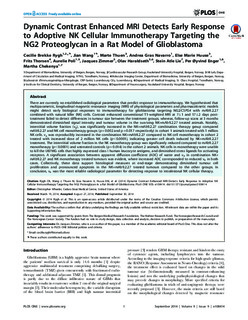| dc.contributor.author | Brekke, Cecilie | |
| dc.contributor.author | Wang, Jian | |
| dc.contributor.author | Thuen, Marte | |
| dc.contributor.author | Gras Navarro, Andrea | |
| dc.contributor.author | Huuse-Røneid, Else Marie | |
| dc.contributor.author | Thorsen, Frits Alan | |
| dc.contributor.author | Poli, Aurélie | |
| dc.contributor.author | Zimmer, Jacques | |
| dc.contributor.author | Haraldseth, Olav | |
| dc.contributor.author | Lie, Stein Atle | |
| dc.contributor.author | Enger, Per Øyvind | |
| dc.contributor.author | Chekenya, Martha | |
| dc.date.accessioned | 2015-03-03T15:07:50Z | |
| dc.date.accessioned | 2015-08-12T13:45:53Z | |
| dc.date.available | 2015-03-03T15:07:50Z | |
| dc.date.available | 2015-08-12T13:45:53Z | |
| dc.date.issued | 2014 | |
| dc.identifier.citation | PLoS ONE 2014, 9(9) | nb_NO |
| dc.identifier.issn | 1932-6203 | |
| dc.identifier.uri | http://hdl.handle.net/11250/296433 | |
| dc.description.abstract | There are currently no established radiological parameters that predict response to immunotherapy. We hypothesised that
multiparametric, longitudinal magnetic resonance imaging (MRI) of physiological parameters and pharmacokinetic models
might detect early biological responses to immunotherapy for glioblastoma targeting NG2/CSPG4 with mAb9.2.27
combined with natural killer (NK) cells. Contrast enhanced conventional T1-weighted MRI at 761 and 1762 days posttreatment
failed to detect differences in tumour size between the treatment groups, whereas, follow-up scans at 3 months
demonstrated diminished signal intensity and tumour volume in the surviving NK+mAb9.2.27 treated animals. Notably,
interstitial volume fraction (ve), was significantly increased in the NK+mAb9.2.27 combination therapy group compared
mAb9.2.27 and NK cell monotherapy groups (p = 0.002 and p = 0.017 respectively) in cohort 1 animals treated with 1 million
NK cells. ve was reproducibly increased in the combination NK+mAb9.2.27 compared to NK cell monotherapy in cohort 2
treated with increased dose of 2 million NK cells (p,0.0001), indicating greater cell death induced by NK+mAb9.2.27
treatment. The interstitial volume fraction in the NK monotherapy group was significantly reduced compared to mAb9.2.27
monotherapy (p,0.0001) and untreated controls (p = 0.014) in the cohort 2 animals. NK cells in monotherapy were unable
to kill the U87MG cells that highly expressed class I human leucocyte antigens, and diminished stress ligands for activating
receptors. A significant association between apparent diffusion coefficient (ADC) of water and ve in combination NK+
mAb9.2.27 and NK monotherapy treated tumours was evident, where increased ADC corresponded to reduced ve in both
cases. Collectively, these data support histological measures at end-stage demonstrating diminished tumour cell
proliferation and pronounced apoptosis in the NK+mAb9.2.27 treated tumours compared to the other groups. In
conclusion, ve was the most reliable radiological parameter for detecting response to intralesional NK cellular therapy. | nb_NO |
| dc.language.iso | eng | nb_NO |
| dc.publisher | Public Library of Science | nb_NO |
| dc.title | Dynamic contrast enhanced MRI detects early response to adoptive NK cellular immunotherapy targeting the NG2 proteoglycan in a rat model of glioblastoma | nb_NO |
| dc.type | Journal article | nb_NO |
| dc.type | Peer reviewed | en_GB |
| dc.date.updated | 2015-03-03T15:07:50Z | |
| dc.source.volume | 9 | nb_NO |
| dc.source.journal | PLoS ONE | nb_NO |
| dc.source.issue | 9 | nb_NO |
| dc.identifier.doi | 10.1371/journal.pone.0108414 | |
| dc.identifier.cristin | 1187273 | |
| dc.description.localcode | (c) 2014 Rygh et al. This is an open-access article distributed under the terms of the Creative Commons Attribution License, which permits unrestricted use, distribution, and reproduction in any medium, provided the original author and source are credited. | nb_NO |
